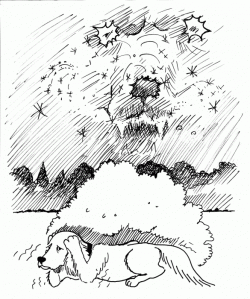Big dog: Thunder, fireworks can fool Rover
Q. When the fireworks start, why does my dog shake and run for cover? –B. Kelly
A. Most dogs do not react to the simple popping of fireworks but rather to the deeper sounds, like the boom of a starburst or the roar of distant rockets, answers psychologist Stanley Coren of the University of British Columbia. It has to do with the low-frequency sounds that seem to come from above and sound to the dog like another dog growling, only this dog is very loud and the sound comes from on high, meaning the unseen dog must be very large and threatening.
This is the same reason why some dogs react negatively to thunder. "A dog big enough to give that kind of growl from that high above them must be one scary dog," Coren says.
Q. The Oxford English Dictionary described finding "kangaroo words" as a "fiendishly difficult word game." Are you word-maven enough to cite a few examples? –A. A. Milne
A. Within the letters of a "marsupial" word "nestles" (and "nests") a small word, or "joey" (baby kangaroo), that means the same as the grown word, says wordsmith Richard Lederer online. The letters of the joey must be in proper order though not entirely adjacent; for example, playing with kangaroo words, your mind will "blossom" and hence "bloom."
Balled up inside your "stockings" are your "socks." Hiding in "nougat" and "neurotic" are two different kinds of "nut." Things "Brobdingnagian" and "lumbering" are "big."
Some kangaroo words even contain multiple joeys: Open up a "container" and you get a "can" and a "tin"; when you've "feasted, you "eat" and have "fed"; and when you "deteriorate," you "rot" and "die." To be "stealthy," "slippery" or "slinky" is to be "sly." To "broadcast" "bombast" is to "boast" and "boast." Lurking in "falsities," "falsifies," "fallacies," "calumnies," "hyperbolizes" and "plagiarizes" is the word "lies."
And, at last, "dead" reposes in "deactivated," "desiccated," "decayed," "disintegrated," "decapitated," "departed" and "deceased."
Q. What is that in your yard flashing the "teeth of a lion," so to speak? –Bl Lahr
A. Can you see the teeth in a dandelion? asks Anu Garg in The Dord, The Diglot, and an Avacado or Two. The word "dandelion" is from the French "dent-de-lion," meaning "tooth of a lion"– since its leaves look like the sharp teeth of the fearsome animal.
Q. Which crystals are for rich folks and which are for the rest of us? –D. Trump
A. Crystals are repeating three-dimensional arrangements of atoms, ions, or molecules, formed of almost any solid material, says Rebecca Coffey in Discover magazine.
The crystals of coveted gemstones are measured by the "carat" (from the Greek "keration" or "carob bean"), which is the standard for weighing small quantities, equal to about .007 ounce. When Richard Burton bought Elizabeth Taylor the heart-shaped Taj-Mahal diamond, he is said to have bragged, "It has so many carats, it's almost a turnip."
A "fancy intense pink" diamond recently went for a world record $46 million at auction. The Cullinan diamond is the largest known gem-quality diamond ever found. It weighed 3,106 carats (nearly a pound and a half) when discovered in South Africa in 1905 but has since been cut into more than 100 stones.
The choice for us commoners is crystallized sodium chloride, or "salt," with enough dissolved in the oceans to make a cube 165 miles on each side. There's also sugar: each American eats more than 130 pounds per year, feeding our epidemics of obesity, tooth decay, and high blood pressure.
~
Send Strange questions to brothers Bill and Rich at
